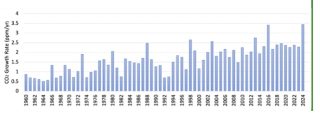-
Carbon emissions rise to new record
Date posted:
-
-
Post Author
Tracey Biller
-
![]()
New research featured in the Financial Times’ Guide to the Climate Graphic of the Week reveals that atmospheric carbon dioxide concentration last year saw the largest one-year increase since records began in 1957.
According to the World Meteorological Organisation’s 16 October Greenhouse Gas Bulletin, the 3.5 ppm increase in CO2 in the global surface atmosphere between 2023 and 2024 is attributable to “continued fossil CO2 emissions” as well as to “enhanced fire emissions, and reduced terrestrial/ocean sinks in 2024, which could signal a climate feedback loop.”
The Financial Times piece also refers to a newly published World Weather Attribution study examining changes in extreme heat trends in the ten years since the Paris Accord. Amongst the key findings from the study is that the world now experiences an average of 11 more hot days per year, with overall warming having increased 0.3°C since 2015.
If current emissions reduction pledges are fully implemented, say the writers, projected warming this century will drop from about 4°C in 2015 to 2.6°C today ̶ far above the Paris goals of keeping warming to 1.5°C and well below 2°C.
In a 2.6°C world, they say, there will be an increase to 57 extra hot days per year. At 4°C, the increase rises to an additional 114 hot days per year.

